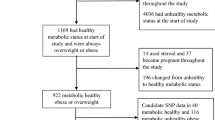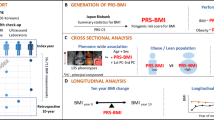Abstract
Objective:
To investigate the impact of lipoprotein lipase (LPL) gene S447X polymorphism on the relation between central obesity and lipid levels.
Design:
A total of 961 adult twin pairs were included from the program of Chinese Twin Registry, between 2001 and 2002. Central obesity was defined as waist circumference ⩾90 cm for male and ⩾80 cm for female. Two statistical methods were performed to test the modification effect of S447X polymorphism of LPL gene on the relation between central obesity and lipid levels: one was Generalized Estimating Equation (GEE) models for all twin pairs and the other was co-twin matched case–control analysis in 82 central obesity discordant monozygotic twin pairs.
Results:
In GEE models for all twins, central obesity was significantly associated with serum lipids except for high-density lipoprotein (HDL), while X447 allele had favorable effects on the levels of triglyceride (TG), HDL and TG to HDL ratio (TG/HDL). The interactions of S447X polymorphism and central obesity were statistically significant for TG/HDL and HDL. In central obesity discordant monozygotic twin pairs, central obesity was significantly related with 26.2% increase of TG and 27.2% increase of TG/HDL in S/S447 genotype, while in 447X allele carrier, central obesity was significantly related with 13.7% increase of HDL.
Conclusion:
These results suggest that LPL gene S447X polymorphism modifies the relation between central obesity and serum lipids, which also stresses the importance of reducing waist circumference to improve serum lipids for people with central obesity, especially those with S/S447 genotype.
This is a preview of subscription content, access via your institution
Access options
Subscribe to this journal
Receive 12 print issues and online access
$259.00 per year
only $21.58 per issue
Buy this article
- Purchase on Springer Link
- Instant access to full article PDF
Prices may be subject to local taxes which are calculated during checkout


Similar content being viewed by others
References
Björntorp P . Obesity. Lancet 1997; 350: 423–426.
Després JP . Health consequences of visceral obesity. Ann Med 2001; 33: 534–541.
Freedman D, Jacobsen S, Barboriak J, Gruchow HW, Anderson AJ, Barboriak JJ . Body fat distribution and male female differences in lipids and lipoproteins. Circulation 1990; 81: 1498–1506.
Wildman RP, Gu D, Reynolds K, Duan X, He J . Appropriate body mass index and waist circumference cutoffs for categorization of overweight and central adiposity among Chinese adults. Am J Clin Nutr 2004; 80: 1129–1136.
Després JP, Moorjani S, Lupien PJ, Tremblay A, Nadeau A, Bouchard C . Genetic aspects of susceptibility to obesity and related dyslipidemias. Mol Cell Biochem 1992; 113: 151–169.
Pouliot MC, Després JP, Moorjani S, Lupien PJ, Tremblay A, Bouchard C . Apolipoprotein E polymorphism alters the association between body fatness and plasma lipoproteins in women. J Lipid Res 1990; 31: 1023–1029.
Pouliot MC, Després JP, Dionne FT, Vohl MC, Moorjarni S, Prudhomme D et al. ApoB-100 gene EcoRI polymorphism associated with abdominal visceral obesity. Arterioscler Thromb 1994; 14: 527–533.
Garenc C, Perusse L, Gagnon J, Chagnon YC, Bergeron J, Després JP et al. Linkage and association studies of the lipoprotein lipase gene with postheparin plasma lipase activities, body fat, and plasma lipid and lipoprotein concentrations: the HERITAGE Family Study. Metabolism 2000; 49: 432–439.
Arca M, Campagna F, Montali A, Barilla F, Mangieri E, Tanzilli G et al. The common mutations in the lipoprotein lipase gene in Italy: effects on plasma lipids and angiographically assessed coronary atherosclerosis. Clin Genet 2000; 58: 369–374.
Lee J, Tan CS, Chia KS, Chew CE, Ordovas JM, Tai ES . The lipoprotein lipase S447X polymorphism and plasma lipids: interactions with APOE polymorphisms, smoking, and alcohol consumption. J Lipid Res 2004; 45: 1132–1139.
Sparkes RS, Zollman S, Klisak I, Kirchgessner TG, Komaromy MC, Mohandas T et al. Human genes involved in lipolysis of plasma lipoproteins: mapping of loci for lipoprotein lipase to 8p22 and hepatic lipase to 15q21. Genomics 1987; 1: 138–144.
Hala A, Robertson M, Emj M, Lalouel JM . Direct detection and automated sequencing of individual alleles after electrophoretic strand separation: identification of a common nonsense mutation in exon 9 of the human lipoprotein lipase gene. Nucleio Acids Res 1990; 18: 5407–5411.
Fisher RM, Humphries SE, Talmud PJ . Common variation in the lipoprotein lipase gene: effects on plasma lipids and risk of atherosclerosis. Atherosclerosis 1997; 135: 145–159.
Kozaki K, Gotoda T, Kawamura M, Shimano H, Yazaki Y, Ouchi Y et al. Mutational analysis of human lipoprotein lipase by carboxy-terminal truncation. J Lipid Res 1993; 34: 1765–1772.
Henderson HE, Kastelein JJ, Zwinderman AH, Gagne E, Jukema JW, Reymer PW et al. Lipoprotein lipase activity is decreased in a large cohort of patients with coronary artery disease and is associated with changes in lipids and lipoproteins. J Lipid Res 1999; 40: 735–743.
Gronemeijer BE, Hallman MD, Reymer PWA, Gagne E, Kuivenhoven JA, Bruin T, et al., on behalf of the REGRESS Study Group. The Ser447-Stop substitution in the lipoprotein lipase gene. Circulation 1997; 95: 2628–2635.
Wittrup H, Tybjaerg-Hansen A, Nordestgaard B . Lipoprotein lipase mutations, plasma lipids and lipoproteins, and risk of ischemic heart disease — a meta-analysis. Circulation 1999; 99: 2901–2907.
Mead JR, Irvine SA, Ramji DP . Lipoprotein lipase: structure, function, regulation, and role in disease. J Mol Med 2002; 80: 753–756.
Preiss-Landl K, Zimmermann R, Hammerle G, Zechner R . Lipoprotein lipase: the regulation of tissue specific expression and its role in lipid and energy metabolism. Curr Opin Lipidol 2002; 13: 471–481.
Greenwood MR . The relationship of enzyme activity to feeding behavior in rats: lipoprotein lipase as the metabolic gatekeeper. Int J Obes 1985; 1: 67–70.
Kern PA . Potential role of TNFα and lipoprotein lipase as candidate genes for obesity. J Nutr 1997; 127: 1917S–1922S.
Yang H, Li X, Cao W, Lu J, Wang T, Zhan S et al. Chinese National Twin Registry as a resource for genetic epidemiologic studies of common and complex diseases in China. Twin Res 2002; 5: 347–351.
Gaziano JM, Hennekens CH, O’Donnell CJ, Breslow JL, Buring JE . Fasting triglycerides, high-density lipoprotein, and risk of myocardial infarction. Circulation 1997; 96: 2520–2525.
McLaughlin T, Abbasi F, Cheal K, Chu J, Lamendola C, Reaven G . Use of metabolic markers to identify overweight individuals who are insulin resistant. Ann Intern Med 2003; 139: 802–809.
Sambrook JFE, Maniatis T (eds). Molecular Cloning: A Laboratory Manual, 2nd edn, Cold Spring Harbor Laboratory Press: New York, 1989.
Lu J, Zhan S, Qin Y, Li Q, Guo X, Cao W et al. Zygosity diagnosis for twins in the epidemiological study. Beijing Da Xue Xue Bao 2003; 35: 212–214 (In Chinese).
The IDF consensus worldwide definition of the metabolic syndrome. Available at: http://www.idf.org/home/ (accessed January 10, 2006).
Evans DM, Gillespie NA, Martin NG . Biometrical genetics. Biol Psychol 2002; 61: 33–51.
Deurenberg P, Deurenberg-Yap M, Guricci S . Asians are different from Caucasians and from each other in their body mass index/body fat percent relationship. Obes Rev 2002; 3: 141–146.
Pouliot MC, Després JP, Lemieux S, Moorjani S, Bouchard C, Tremblay A et al. Waist circumference and abdominal sagittal diameter: best simple anthropometric indexes of abdominal visceral adipose tissue accumulation and related cardiovascular risk in men and women. Am J Cardiol 1994; 73: 460–468.
Janssen I, Katzmarzyk PT, Ross R . Waist circumference and not body mass index explains obesity-related health risk. Am J Clin Nutr 2004; 79: 379–384.
Wajchenberg BL . Subcutaneous and visceral adipose tissue: their relation to the metabolic syndrome. Endocr Rev 2000; 21: 697–739.
Roberts CK, Barnard RJ, Liang KH, Vaziri ND . Effect of diet on adipose tissue and skeletal muscle VLDL receptor and LPL: implications for obesity and hyperlipidemia. Atherosclerosis 2002; 161: 133–141.
Mantha L, Russell JC, Brindley DN, Deshaies Y . Developmental changes in adipose and muscle lipoprotein lipase activity in the atherosclerosis-prone JCR: LA-corpulent rat. Int J Obes Relat Metab Disord 2002; 26: 308–317.
Wittrup HH, Nordestgaard BG, Steffensen R, Jensen G, Tybjaerg-Hansen A . Effect of gender on phenotypic expression of the S447X mutation in LPL: the Copenhagen City Heart Study. Atherosclerosis 2002; 165: 119–126.
Guo SW . Gene-environment interaction and the mapping of complex traits: some statistical models and their implications. Hum Hered 2000; 50: 286–303.
Senti M, Bosch M, Aubo C, Elosua R, Masia R, Marrugat J . Relationship of abdominal adiposity and dyslipemic status in women with a common mutation in the lipoprotein lipase gene. The REGICOR investigators. Atherosclerosis 2000; 150: 135–141.
Vohl MC, Lamarche B, Moorjani S, Prudhomme D, Nadeau A, Bouchard C et al. The lipoprotein lipase HindIII polymorphism modulates plasma triglyceride levels in visceral obesity. Arterioscler Thromb Vasc Biol 1995; 15: 714–720.
Ko YL, Ko YS, Wu SM, Teng MS, Chen FR, Hsu TS et al. Interaction between obesity and genetic polymorphisms in the apolipoprotein CIII gene and lipoprotein lipase gene on the risk of hypertriglyceridemia in Chinese. Hum Genet 1997; 100: 327–333.
MacGregor AJ, Snieder H, Schork NJ, Spector TD . Twins, novel uses to study complex traits and genetic diseases. Trends Genet 2000; 16: 131–134.
The Asia-Pacific Perspective: Redefining Obesity and its Treatment. Available at: http://www.diabetes.com.au/research.php?regionID=194,Accessed January 10, 2006.
Savard R, Bouchard C . Genetic effects in the response of adipose tissue lipoprotein lipase activity to prolonged exercise: a twin study. Int J Obes Relat Metab Disord 1990; 14: 771–777.
Nicklas BJ, Ferrell RE, Rogus EM, Berman DM, Ryan AS, Dennis KE et al. Lipoprotein lipase gene variation is associated with adipose tissue lipoprotein lipase activity, and lipoprotein lipid and glucose concentrations in overweight postmenopausal women. Hum Genet 2000; 106: 420–424.
Acknowledgements
This work was partly supported by China Medical Board of New York (01-746) and National Natural Science Foundation of China (30070672). We gratefully acknowledge the assistance and cooperation of the staff of Center for Disease Control and Prevention in Qingdao city and Lishui city. We are thankful to all the participants in our study and their families.
Author information
Authors and Affiliations
Corresponding author
Rights and permissions
About this article
Cite this article
Huang, A., Hu, Y., Zhan, S. et al. Lipoprotein lipase gene S447X polymorphism modulates the relation between central obesity and serum lipids, a twin study. Int J Obes 30, 1693–1701 (2006). https://doi.org/10.1038/sj.ijo.0803332
Received:
Revised:
Accepted:
Published:
Issue Date:
DOI: https://doi.org/10.1038/sj.ijo.0803332
Keywords
This article is cited by
-
Gene-environment interactions due to quantile-specific heritability of triglyceride and VLDL concentrations
Scientific Reports (2020)
-
Genetic basis of interindividual susceptibility to cancer cachexia: selection of potential candidate gene polymorphisms for association studies
Journal of Genetics (2014)
-
Association of lipoprotein lipase polymorphism rs2197089 with serum lipid concentrations and LPL gene expression
Journal of Human Genetics (2013)
-
Genetic and environmental influences on blood pressure and body mass index in Han Chinese: a twin study
Hypertension Research (2011)
-
Association of lipoprotein lipase and apolipoprotein C-III genes polymorphism with acute myocardial infarction in diabetic patients
Molecular and Cellular Biochemistry (2011)



